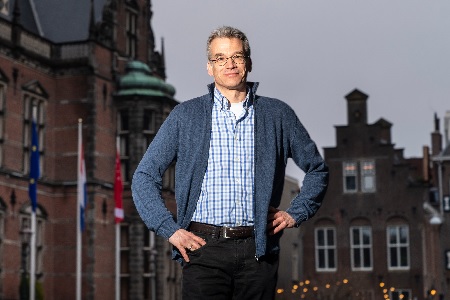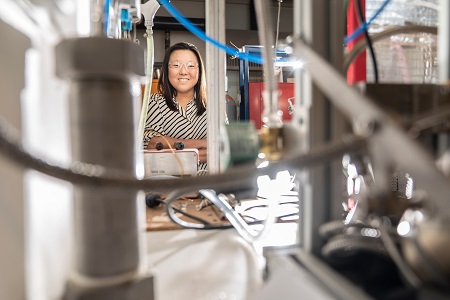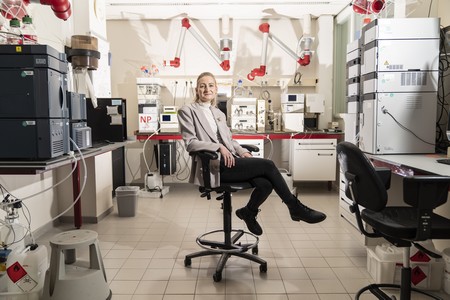The future of carbon is green
Our society must end its addiction to oil and gas. This means that we need a new source of hydrocarbons, the carbon compounds from which fuels and many fossil-based materials are made. Some two years ago, Matthias Heinemann, Professor of Biochemistry at the University of Groningen, began wondering how the Netherlands could get involved in realizing the shift to fossil-free carbon. He is now part of a small team that leads a large consortium of knowledge institutes and partners from industry that has put forward a proposal that could revolutionize the chemical industry. The FutureCarbonNL consortium proposes to make valuable chemicals from the carbon dioxide found in waste gases and even from that found in the air.
A biochemist may seem an unlikely champion for a greener chemical industry. ‘If our proposal is funded, I am unlikely to benefit from it,’ Heinemann acknowledges. His research interest lies in the metabolism of microorganisms, which has very little to do with carbon capture and utilization, the general idea behind the €663 million proposal for the Dutch National Growth Fund, a government fund that aims to increase the Dutch economic earning power.

Factory chimneys
Heinemann became interested in this area when he heard that the EU wanted to invest hundreds of millions of euros in the province of Groningen to compensate for the loss of jobs in the Groningen fossil industry. ‘I started to think about how all this money could be invested in the best possible way,’ recalls Heinemann. The best option, he felt, would be to exploit a new source of carbon. ‘In a green economy, we have to replace fossil carbon in our daily products with a green alternative. Obtaining carbons through recycling is not enough, and using biomass as a carbon source would compete with food production.’
A third option is to source carbon from factory chimneys. The industry emits carbon dioxide in large quantities, which is causing global warming. Heinemann: ‘It is possible to convert this into useful carbon-based molecules by combining it with hydrogen.’ He feels that the Netherlands is uniquely poised to develop an industry that turns CO2 waste gas into useful compounds. ‘You need green hydrogen, created by electrolysis of water using green energy. There are plenty of wind parks in the North Sea and there has already been a substantial investment in hydrogen production capacity.’

Jet fuel
Together with the FutureCarbonNL core team, he built on this idea. ‘My interest is that of the tax payer. I want government money to be spent well. In this case, the huge sums invested in a green economy.’ Unlike most tax payers, Heinemann could help to realize these ideas in discussions he had with the provincial government, the chemical industry, and other stakeholders.
The result is the FutureCarbonNL proposal, which asks for an investment of €663 million from the government and adds another €767 million through partner investments, mainly from the industrial partners. Heinemann: ‘The idea is to develop the technology to capture carbon and turn this into new molecules.’ A first generation of this technology already exists. ‘We want to develop the second and third generation of this technology. The Netherlands has a strong chemical industry, a lot of green energy, and excellent scientists in chemistry research institutes.’ In the future, it might even be feasible to capture carbon dioxide from the air around us, and use this to produce green jet fuel, new materials and even animal feed.

Open competition
The Royal Association of the Dutch Chemical Industry (VNCI) is involved in the proposal, as are universities, research institutes, green startups, big companies, and government agencies. ‘If we succeed, it will be very good for the economy and for the environment–in this country and all over the world.’ If the FutureCarbonNL proposal is funded, the money will be divided in an open competition. ‘None of the current partners have been guaranteed money from the programme. I don’t like it when the initiators automatically get their share. Again, as a tax payer, I want the money to go to the best possible research proposals.’
Some initial research has already been carried out (see, for example, these two projects by Sandy Schmid and Jingxiu Xie). The FutureCarbonNL proposal has cleared the first two selection hurdles and will be submitted on 3 February. Later this summer, the final verdict will be known. ‘The competition is fierce. But we’ve worked hard on our proposal and, in my opinion, we’ve built a very solid case.’
See also the FutureCarbonNL website.
| Last modified: | 03 October 2023 3.43 p.m. |
More news
-
13 May 2024
Trapping molecules
In his laboratory, physicist Steven Hoekstra is building an experimental set-up made of two parts: one that produces barium fluoride molecules, and a second part that traps the molecules and brings them to an almost complete standstill so they can...
-
29 April 2024
Tactile sensors
Every two weeks, UG Makers puts the spotlight on a researcher who has created something tangible, ranging from homemade measuring equipment for academic research to small or larger products that can change our daily lives. That is how UG...
-
16 April 2024
UG signs Barcelona Declaration on Open Research Information
In a significant stride toward advancing responsible research assessment and open science, the University of Groningen has officially signed the Barcelona Declaration on Open Research Information.

